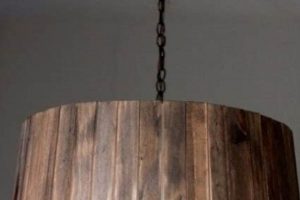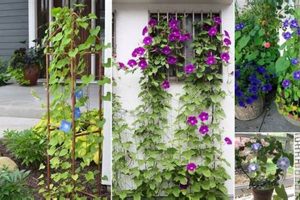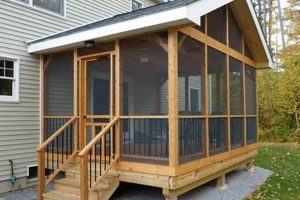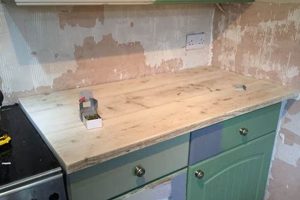The concept embodies creative projects centered on transforming mirrors through do-it-yourself methods. These projects encompass a wide array of modifications, including embellishing mirror frames, altering the mirror’s shape, or incorporating mirrors into novel decorative elements. A tangible example is the addition of mosaic tiles to a plain mirror frame, resulting in a personalized and visually appealing piece.
These endeavors offer a cost-effective approach to enhancing interior aesthetics, promoting resourcefulness and creative expression. Historically, mirror customization has allowed individuals to adapt reflective surfaces to evolving design sensibilities and practical needs, thus maintaining relevance across varied stylistic periods. Beyond visual enhancements, such projects encourage the development of practical skills and provide a satisfying sense of accomplishment.
Subsequent discussion will explore diverse approaches to mirror transformation, encompassing techniques, materials, and design considerations relevant to achieving successful and aesthetically pleasing outcomes.
Essential Considerations for Mirror Transformation Projects
Successful execution requires careful planning and attention to detail. Prior consideration of these tips will contribute significantly to the overall quality and longevity of the finished piece.
Tip 1: Material Selection: Evaluate material compatibility with the mirror’s surface. Adhesives should be specifically designed for use with glass to prevent damage to the reflective coating. For framing materials, consider moisture resistance, particularly for environments prone to humidity.
Tip 2: Surface Preparation: Thoroughly clean the mirror surface before commencing any modification. Use a glass cleaner to remove dirt, grease, and fingerprints. Ensure the surface is completely dry before applying adhesives or decorative elements.
Tip 3: Accurate Measurement and Planning: Precisely measure the mirror and any accompanying materials to ensure accurate cuts and proper alignment. Create a detailed plan or sketch of the desired design before initiating the project. This mitigates errors and material waste.
Tip 4: Adhesion Techniques: Employ appropriate adhesion methods for the selected materials. Use a thin, even layer of adhesive to prevent seepage and unsightly residue. Secure the materials with clamps or weights during the curing process to ensure optimal bonding.
Tip 5: Edge Treatment: Pay close attention to the edges of the mirror and any applied materials. Sharp edges should be carefully sanded or filed to prevent injury. Consider applying edge banding or sealant to protect against moisture infiltration and chipping.
Tip 6: Safety Precautions: Wear appropriate safety gear, including eye protection and gloves, when working with glass, adhesives, and cutting tools. Work in a well-ventilated area to minimize exposure to fumes. Dispose of waste materials responsibly.
Adhering to these principles fosters both artistic expression and structural integrity in mirror enhancement projects. Through proper planning and meticulous execution, durable and visually appealing pieces can be created.
The following section will address specific design styles and techniques for accomplishing varied project goals.
1. Frame Material Selection
Frame material selection is a pivotal element within the spectrum of mirror customization activities. The choice of framing material dictates not only the aesthetic character of the final piece but also its durability and suitability for its intended environment.
- Wood Frames: Aesthetic Versatility and Structural Considerations
Wood offers diverse aesthetic possibilities, accommodating various styles from rustic to contemporary. Different wood types offer varying levels of durability and moisture resistance. Softwoods like pine are easier to work with but require sealing in humid environments. Hardwoods, such as oak or maple, offer greater structural integrity but demand specialized cutting and finishing tools. The choice influences the project’s longevity and the labor required for completion.
- Metal Frames: Modern Aesthetics and Corrosion Resistance
Metal frames provide a sleek, contemporary aesthetic and offer inherent durability. Aluminum, steel, and wrought iron are common choices. Aluminum offers lightweight corrosion resistance, while steel provides superior strength. Wrought iron introduces an element of handcrafted elegance. However, proper coating or treatment is necessary to prevent rust or oxidation, particularly in bathrooms or outdoor settings.
- Composite Materials: Cost-Effectiveness and Moisture Resistance
Composite materials, such as MDF (Medium-Density Fiberboard) or polystyrene, offer a cost-effective alternative to solid wood. These materials are typically moisture-resistant and readily available. MDF is easy to paint and provides a smooth surface for embellishments. Polystyrene is lightweight and suitable for intricate designs. However, these materials may lack the structural integrity and aesthetic appeal of natural wood or metal.
- Repurposed Materials: Sustainability and Unique Aesthetics
Employing repurposed materials, such as reclaimed wood, vintage moldings, or recycled plastics, aligns with sustainable practices and yields unique, one-of-a-kind mirror frames. Reclaimed wood offers rustic charm and historical character. Vintage moldings add intricate detailing and architectural interest. Recycled plastics contribute to environmental consciousness. However, repurposing requires careful material selection, cleaning, and preparation to ensure structural integrity and aesthetic compatibility.
The selection of appropriate framing materials is instrumental in achieving the desired aesthetic, ensuring structural soundness, and prolonging the lifespan of customized mirrors. Careful consideration of material properties and environmental factors ultimately dictates the success of these projects.
2. Surface Embellishment Techniques
Surface embellishment techniques are integral to realizing diverse aesthetic visions within mirror DIY projects. They represent the methods by which the mirror’s surface, either its frame or the reflective glass itself (when executed safely and appropriately), is modified to enhance visual appeal. The application of such techniques directly affects the style, character, and overall impact of the finished piece. For example, applying mosaic tiles to a mirror frame transforms a commonplace item into a textured, visually striking decorative element. Similarly, etching designs onto the glass, though requiring specialized tools and caution, creates personalized, subtle patterns that integrate seamlessly into the mirrored surface. T
he successful employment of surface embellishment techniques is, therefore, a crucial determinant of a mirror DIY project’s ultimate success.
A further exploration of surface embellishment reveals a spectrum of possibilities, from simple painting and staining to more complex methods such as decoupage, stenciling, or the application of gilding. Consider the application of decoupage, where paper cutouts are adhered to the frame and sealed with varnish, to create a collage-like effect. The aesthetic range is broad, extending from vintage-inspired floral patterns to bold, modern geometric designs. Another example is the use of stenciling to apply intricate designs onto the frame, offering a controlled method of creating repeating patterns or complex images. The choice of technique is often guided by the desired style, skill level, and available resources. Careful consideration of these factors is critical for projects to yield the expected visual outcomes.
In summary, surface embellishment techniques are a cornerstone of mirror DIY initiatives, offering a range of options to transform mirrors into unique decorative pieces. Understanding the potential of these techniques, along with their corresponding limitations and safety considerations, is essential for achieving desired results. The techniques connect directly to the broader theme of creative expression and functional enhancement, defining not just the appearance but also the perceived value of the customized mirror.
3. Shape Alteration Possibilities
Shape alteration constitutes a significant dimension within the broader scope of do-it-yourself mirror projects. This aspect concerns the modification of a mirror’s original form to achieve a desired aesthetic or functional outcome, differentiating it from mere surface embellishment or frame enhancement. Such alterations demand precision, specialized tools, and a clear understanding of glass manipulation techniques.
- Geometric Transformations
Geometric transformations involve cutting existing mirrors into defined shapes such as triangles, hexagons, or complex polygons. This technique finds application in creating mosaic mirror installations, where small geometric pieces are arranged to form a larger, cohesive design. The implication for projects lies in the ability to produce custom, mathematically precise designs impossible with standard, pre-fabricated mirrors.
- Freeform Cuts and Organic Shapes
Freeform cuts deviate from strict geometric forms, allowing for the creation of organic, asymmetrical shapes. This approach lends itself to artistic mirror collages or statement pieces where the mirror serves as an abstract sculptural element. The technique demands a higher degree of artistic skill and control, as deviations from the intended shape are readily apparent.
- Incorporation of Multiple Mirror Segments
This approach involves combining multiple, smaller mirror segments to construct a larger, composite mirror. This allows for the creation of large-scale installations or the adaptation of existing mirrors to fit specific spaces. The joins between segments become a design element, necessitating careful alignment and finishing to maintain visual continuity.
- Layering and Relief Techniques
Layering involves stacking multiple mirror pieces of varying sizes or shapes to create a three-dimensional, relief effect. This technique adds depth and visual interest, transforming a flat mirror into a sculptural object. The structural integrity of the layered assembly becomes a primary consideration, requiring robust adhesives and secure mounting methods.
In summary, shape alteration provides a powerful means of customizing mirrors beyond surface treatments or framing. These alterations necessitate a balance of technical proficiency and artistic vision. Successful execution enhances the mirror’s aesthetic value and optimizes its functional integration within a designed space.
4. Adhesive Compatibility Testing
The longevity and aesthetic integrity of mirror DIY projects hinge critically on adhesive compatibility testing. An ill-suited adhesive can catalyze a range of undesirable outcomes, from delamination and structural failure to irreversible damage to the mirror’s reflective coating. The selection process thus transcends mere adhesive strength and necessitates a thorough evaluation of chemical interactions between the adhesive and the mirror’s constituent materials.
A primary concern is the potential for adhesive components to corrode the silver or aluminum backing of the mirror, leading to unsightly blemishes known as “desilvering.” Ammonia-based adhesives, for example, are particularly notorious for this effect. Empirical evidence suggests that even adhesives labeled as “mirror-safe” can exhibit variable performance depending on the specific mirror substrate. Therefore, a preliminary spot test, conducted on an inconspicuous area of the mirror, is an essential safeguard against widespread damage. Proper testing should involve applying the adhesive, allowing it to cure fully according to the manufacturer’s instructions, and then meticulously inspecting for signs of discoloration, bubbling, or detachment.
In conclusion, adhesive compatibility testing is an indispensable step in any mirror DIY undertaking. Ignoring this crucial precaution can result in cosmetic defects, structural weaknesses, and ultimately, the premature failure of the project. The proactive evaluation of adhesive properties, coupled with judicious selection and application techniques, mitigates risk and ensures the enduring quality of customized mirrors.
5. Reflective Surface Preservation
Reflective surface preservation represents a critical facet of successful do-it-yourself mirror projects. The integrity of the mirror’s reflective coating directly impacts the visual quality and longevity of the finished product. Neglecting preservation techniques can lead to irreversible damage, diminishing the aesthetic appeal and potentially rendering the mirror unusable.
- Cleaning Agent Selection
The choice of cleaning agents is paramount. Abrasive cleaners or those containing ammonia can corrode the delicate silver or aluminum backing, resulting in desilvering and a loss of reflectivity. Instead, employ pH-neutral glass cleaners specifically formulated for mirrors. Regular cleaning with a soft, lint-free cloth further minimizes the risk of surface scratches and maintains optimal clarity.
- Handling Techniques During Modification
During alterations such as cutting, etching, or embellishing, the reflective surface is particularly vulnerable. Applying protective films or coatings before commencing work safeguards against accidental scratches, chemical exposure, and abrasive damage. Securing the mirror firmly during these processes also minimizes vibration and potential for surface marring.
- Adhesive and Coating Application
When applying adhesives or protective coatings, ensure they are explicitly designated as mirr
or-safe. Certain adhesives can chemically react with the reflective backing, causing discoloration or delamination. Employing thin, even layers of adhesive minimizes the risk of seepage and subsequent damage to the reflective layer. - Environmental Considerations
Environmental factors, such as humidity and temperature fluctuations, can accelerate the degradation of the reflective surface. In high-humidity environments, sealing the edges of the mirror with a moisture-resistant sealant helps prevent water infiltration and subsequent corrosion. Avoiding direct exposure to sunlight also reduces the risk of fading and discoloration over time.
These preservation strategies, when implemented consistently, ensure that do-it-yourself mirror projects retain their aesthetic value and functional integrity over extended periods. A proactive approach to surface protection is integral to realizing the full potential of mirror customization.
Frequently Asked Questions About Mirror DIY Projects
The following addresses common inquiries regarding do-it-yourself mirror modifications, providing clarification on key aspects of project planning and execution.
Question 1: What adhesive types are considered safe for use with mirrors without damaging the reflective backing?
Adhesives specifically formulated for mirror applications, often labeled as “mirror adhesive” or “mirror mastic,” are recommended. These are typically neutral-cure and avoid chemical compounds that can corrode the reflective coating. Always verify product specifications before application.
Question 2: How can a mirror be safely cut to a custom shape at home?
Cutting mirrors requires specialized tools, including a glass cutter, straightedge, and safety equipment. Score the glass firmly along the desired line, then apply pressure to snap the mirror along the score. Exercise caution to prevent shattering. For complex shapes, professional glass cutting services are advisable.
Question 3: What precautions should be taken when applying paint or other coatings to a mirror frame?
Thoroughly clean the frame surface and lightly sand it to create a receptive surface. Use a primer appropriate for the frame material, followed by the desired paint or coating. Allow adequate drying time between coats, and apply a sealant for added protection. Ensure adequate ventilation during application.
Question 4: How can the edges of a mirror be finished to prevent chipping or cracking?
Mirror edges can be finished using edge banding, specialized edge sealants, or by sanding with progressively finer grits of sandpaper. Edge banding provides a protective barrier, while sealants prevent moisture infiltration. Sanding smooths sharp edges and reduces the risk of chipping.
Question 5: What are the key factors to consider when hanging a large, customized mirror?
Ensure the wall is structurally sound and capable of supporting the mirror’s weight. Use appropriate hanging hardware, such as heavy-duty D-rings or Z-clips. Employ a level to ensure accurate placement. For particularly heavy mirrors, consider professional installation.
Question 6: How can the reflective surface of a mirror be protected during a DIY project?
Apply a protective film or coating to the reflective surface before commencing any modifications. This shields against scratches, chemical exposure, and abrasive damage. Clean the mirror with a soft, lint-free cloth and a pH-neutral glass cleaner after the project is complete.
Careful planning, material selection, and adherence to safety guidelines are essential for successful mirror DIY projects.
The subsequent section will explore advanced techniques and design inspirations for mirror customization.
Concluding Remarks on Mirror DIY Ideas
This exposition has detailed the multifaceted aspects of mirror DIY ideas. It has traversed considerations ranging from material selection and surface embellishment to shape alteration and reflective surface preservation. Adherence to established techniques and thorough preparation are key determinants of success in this domain.
The principles outlined provide a foundation for the transformation of commonplace mirrors into bespoke decorative elements. Further exploration of advanced methodologies and innovative design concepts offers potential for expanding the creative scope and enhancing the functional value of reflective surfaces within interior spaces. Continuing refinement of skills and techniques will allow for ever more ambitious and aesthetically pleasing mirror DIY executions.



![Creative DIY Mobile Home Skirting Ideas [Guide] The DIY Hub: Creative Crafts, Repairs & Life Hacks Creative DIY Mobile Home Skirting Ideas [Guide] | The DIY Hub: Creative Crafts, Repairs & Life Hacks](https://craftingdiycenter.com/wp-content/uploads/2025/07/th-4605-300x200.jpg)



